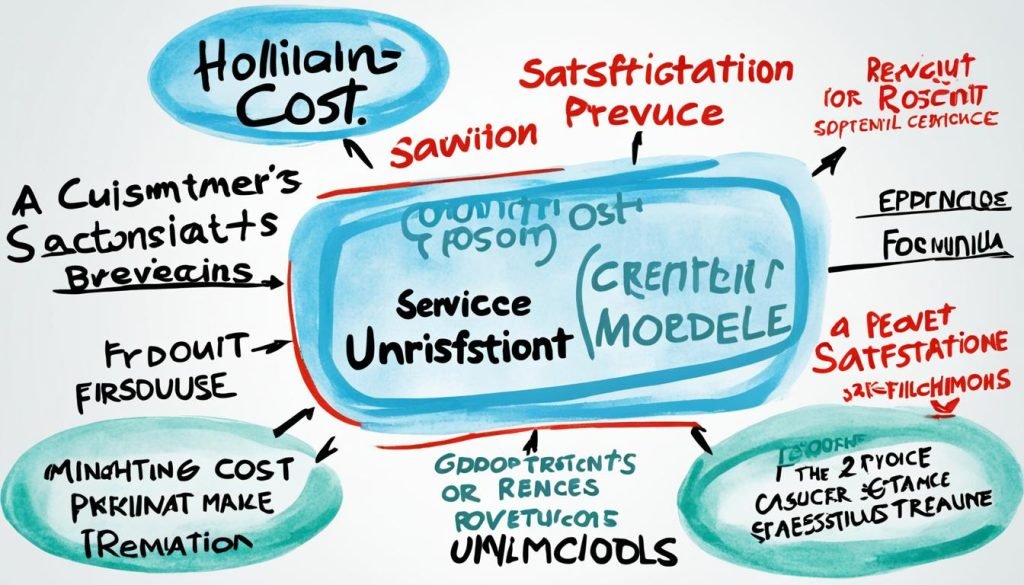
In today’s fast-paced business world, business model innovation is key for growth. Traditional methods might not cut it anymore. Companies need to check their strategies often to find ways to get better.
This is crucial because only a tiny part of innovation funds goes to new business models. By focusing on growth strategies and changing with the market, businesses can keep ahead. Being innovative makes a company stand out and helps it succeed in a changing world.
Key Takeaways
- Business model innovation is vital for achieving sustainable growth.
- Regular assessments of business strategies can reveal areas for improvement.
- Only a small fraction of innovation funding is directed towards new business models.
- Adapting to market changes enhances competitive advantage.
- Innovative practices are key to remaining relevant in dynamic markets.
The Importance of Business Model Innovation
In today’s fast-paced world, adapting through business model innovation is key for success. It’s vital to understand the market to make strategies that keep you ahead. Knowing the latest trends helps companies stay on top.
Understanding Current Market Dynamics
Market dynamics include economic, technological, and social forces. By studying these, businesses can make smart choices. For example, changes in what people want and new tech open doors for innovation.
Companies that keep an eye on these changes can tweak their plans to meet new customer needs.
Identifying Customer Needs
Businesses that focus on what customers need do well in innovation. Matching what you offer with what customers want boosts profits and loyalty. Apple is a great example of this. They listen to what people want and make products that hit the mark.
This approach helps companies grow and stay connected with their customers.
Key Elements of a Successful Business Model
A successful business model has key parts that make it work well and last. These parts include the customer value proposition, profit formula, and key resources. They help businesses grow and stay strong in tough markets.
The Customer Value Proposition
The customer value proposition meets the needs and wants of target customers. It shows how a product or service solves problems or meets desires. This leads to more satisfaction and loyalty. A strong proposition helps businesses get into the market and build lasting relationships.
The Profit Formula
The profit formula shows how a business makes money by delivering value. It looks at pricing, costs, and profits from different customers. A clear profit formula is key for making money and using resources well.
Essential Resources and Processes
Key resources like technology, people, and partnerships are vital for a business. They help businesses innovate, grow, and adapt to changes. Knowing how to use these resources well is important for growth.

| Element | Description | Importance |
|---|---|---|
| Customer Value Proposition | A statement that outlines how a product/service meets customer needs. | Enhances customer loyalty and drives market differentiation. |
| Profit Formula | Blueprint for revenue generation and financial sustainability. | Guides pricing strategies and financial planning. |
| Key Resources | Critical assets and partnerships essential for operation. | Enables innovation and efficient market response. |
Frameworks for Effective Business Model Innovation
Companies looking to grow need frameworks that help with business model innovation. Tools like the business model canvas, lean canvas, and design thinking offer structured ways to plan and improve strategies. These methods make it easier to see and organize ideas, helping companies stay ahead in fast-changing markets.
Business Model Canvas
The business model canvas is a tool for strategic planning. It helps companies lay out their business by focusing on nine key areas. These include customer segments, value propositions, and revenue streams, among others. This framework helps companies understand their operations better and align on how to create value.
Lean Canvas
The lean canvas is made for startups and focuses on quick testing of business ideas. It lets businesses list their assumptions and change them based on feedback. By focusing on problems, solutions, and key metrics, the lean canvas helps avoid wasting time on ideas that won’t work.
Design Thinking in Business Models
Design thinking puts the customer at the center of business model innovation. It uses empathy to understand what customers need, leading to more creative solutions. Adding design thinking to the innovation process creates a culture where insights lead to real strategies, improving customer satisfaction and engagement.
| Framework | Focus Area | Benefits |
|---|---|---|
| Business Model Canvas | Business structure and relationships | Cohesion in value proposition clarity |
| Lean Canvas | Rapid validation and iteration | Efficient resource allocation |
| Design Thinking | User needs and empathy | Enhanced customer engagement and satisfaction |
Embracing Disruptive Innovation
Disruptive innovation changes industries by meeting needs that haven’t been met before or by bringing new technologies. Companies need to watch for these chances. By seeing changes in the market, they can grab new trends and stay ahead.
Recognizing Opportunities through Disruption
Finding new market chances often depends on knowing how new innovations change what customers want and do. Companies that keep an eye on tech and customer needs can adjust their plans better. This way, they avoid becoming outdated and find new ways to grow.
Case Studies: Successful Disruptors
Looking at successful disruptors shows how big changes can happen in markets. For instance, Apple’s iPod and iTunes changed the music industry. This shows how being quick to act and see what’s coming is key to success.
Strategies for Developing Business Agility
In today’s fast-changing market, being agile is key to success. Companies need to quickly adapt to new challenges and chances. This quick adaptability helps them stay ahead and meet what customers want. Using lean startups is a big help in being adaptable.
Adapting to Change
Adapting to change means creating a flexible and quick-reacting culture. It’s about making fast decisions to keep up with the market and what customers say. Agile frameworks help teams handle changes smoothly while keeping everyone motivated and productive.
These methods push for constant betterment and new ideas. They make sure customer needs stay the main focus.
Leveraging Lean Startups
Lean startups bring big benefits for business agility. They focus on launching basic products to test ideas with low risk. This approach boosts innovation and gets customers involved through feedback.
Testing and refining products based on real feedback lets companies make better choices. This approach keeps them in line with what customers want, building loyalty.
| Strategy | Description | Benefits |
|---|---|---|
| Minimum Viable Products | Launch basic versions of products to gather user feedback | Reduced risk, faster market entry |
| Agile Frameworks | Employ iterative development and continuous feedback | Enhanced adaptability, higher quality outcomes |
| Customer-Centric Design | Involve customers in the design process | Improved product-market fit, increased customer satisfaction |
Implementing the Blue Ocean Strategy
Today, businesses face tough competition, making it hard to stand out. The blue ocean strategy helps by creating new demand and finding “white space” in the market. It focuses on innovation and adding value to spot unique growth chances that others miss.
Finding “White Space” Growth Opportunities
Finding “white space” means looking for areas where customers need something new. This means moving away from traditional competition. By studying what customers want and market trends, companies can come up with new solutions. They can:
- Do deep market research to find gaps.
- Talk to customers to learn what they really want.
- Look at competitors’ weaknesses for new chances to grow.
Breaking Free from Competition
The blue ocean strategy is about escaping competition by changing the market rules. Instead of fighting in the same old markets, companies can make new ones. This lets them focus on adding value. For example:
- Make unique products that solve specific problems.
- Use technology to improve services and customer experience.
- Work with partners from different fields to innovate.

By using the blue ocean strategy and finding “white space” chances, companies can stand out and lead in their areas.
Conclusion
Business model innovation is key to growing and staying ahead in today’s fast market. It’s important to understand what customers need and how to meet those needs. This sets the stage for success.
With the right strategies and tools, companies can use their unique strengths to adapt and grow. This helps them stay ahead in a changing world.
Using frameworks for business model innovation makes it easier to spot and grab new chances. By using new ideas and strategies, businesses can move beyond usual competition. They can enter new areas.
Being open to change and improving your business model helps you grow stronger. With a focus on innovation, companies can lead the way and succeed, even when things get tough. Investing in new ideas now means a better future ahead.




43 replies on “Innovating Your Business Model for Growth”
Im now not certain the place you are getting your information, but great topic. I needs to spend a while learning more or figuring out more. Thanks for fantastic information I used to be looking for this info for my mission.
There is clearly a bundle to know about this. I consider you made various good points in features also.
I also believe therefore, perfectly indited post! .
Excellent website you have here but I was curious if you knew of any message boards that cover the same topics discussed here? I’d really like to be a part of group where I can get advice from other knowledgeable individuals that share the same interest. If you have any suggestions, please let me know. Thanks a lot!
I simply had to thank you very much yet again. I am not sure the things that I would have followed without these creative ideas contributed by you relating to that field. It had been an absolute difficult scenario in my position, however , being able to view a new skilled avenue you treated it forced me to weep with joy. I am just grateful for the support and in addition have high hopes you really know what an amazing job you are always undertaking educating people today via your blog. I am sure you have never come across any of us.
I loved as much as you’ll receive carried out right here. The sketch is tasteful, your authored material stylish. nonetheless, you command get got an impatience over that you wish be delivering the following. unwell unquestionably come more formerly again as exactly the same nearly a lot often inside case you shield this increase.
What’s Happening i am new to this, I stumbled upon this I’ve discovered It positively useful and it has helped me out loads. I hope to give a contribution & help different customers like its aided me. Good job.
Woah! I’m really enjoying the template/theme of this site. It’s simple, yet effective. A lot of times it’s challenging to get that “perfect balance” between user friendliness and visual appearance. I must say that you’ve done a fantastic job with this. Also, the blog loads extremely fast for me on Opera. Outstanding Blog!
Unquestionably believe that which you said. Your favorite justification seemed to be on the web the simplest thing to be
aware of. I say to you, I definitely get annoyed while people think about worries that they just don’t know about.
You managed to hit the nail upon the top and defined out the
whole thing without having side-effects , people can take
a signal. Will likely be back to get more. Thanks
Look at my web page … nordvpn coupons inspiresensation
I will immediately take hold of your rss as I can not to find your email subscription hyperlink or newsletter service. Do you have any? Kindly allow me realize so that I could subscribe. Thanks.
Right now it looks like WordPress is the preferred blogging
platform available right now. (from what I’ve read) Is that what
you’re using on your blog?
Look at my webpage; nordvpn coupons inspiresensation [tinyurl.com]
This is really interesting, You’re a very skilled blogger.
I’ve joined your rss feed and look forward to seeking more of your excellent post.
Also, I have shared your website in my social networks!
My web blog: nordvpn coupons inspiresensation, ur.link,
nordvpn special coupon code 2025 350fairfax
Hello, this weekend is nice in support of me, because this point in time i am reading this fantastic informative piece
of writing here at my home.
It is appropriate time to make some plans for the longer term and it’s time to be happy. I’ve read this publish and if I may I wish to recommend you some fascinating issues or suggestions. Perhaps you could write next articles relating to this article. I want to read even more issues about it!
Its wonderful as your other blog posts : D, regards for posting.
Usually I don’t learn article on blogs, however I would like to say that this write-up very
compelled me to take a look at and do it! Your writing style has
been amazed me. Thanks, quite great post.
Also visit my blog: eharmony special coupon code 2025
Good ?V I should certainly pronounce, impressed with your website. I had no trouble navigating through all the tabs as well as related information ended up being truly easy to do to access. I recently found what I hoped for before you know it in the least. Reasonably unusual. Is likely to appreciate it for those who add forums or anything, site theme . a tones way for your customer to communicate. Nice task..
Its fantastic as your other articles : D, thanks for posting.
It’s genuinely very complex in this full of activity life to listen news on TV, so I simply use
web for that purpose, and get the newest information.
my website; vpn
This web site is really a walk-through for all of the info you wanted about this and didn’t know who to ask. Glimpse here, and you’ll definitely discover it.
Simply wanna input that you have a very decent internet site, I love the pattern it really stands out.
I am not real superb with English but I get hold this rattling leisurely to read .
I have read a few excellent stuff here. Certainly value bookmarking for revisiting. I surprise how so much attempt you place to create such a excellent informative web site.
Hey there! This is kind of off topic but I need some guidance from an established blog.
Is it tough to set up your own blog? I’m not very techincal but I
can figure things out pretty fast. I’m thinking about setting up
my own but I’m not sure where to begin. Do you have any points or suggestions?
Many thanks https://tinyurl.com/235hnz7u gamefly free trial
I blog often and I really appreciate your content.
Your article has truly peaked my interest.
I will book mark your website and keep checking for
new details about once a week. I subscribed
to your Feed too. https://tinyurl.com/2bm4xgrn what vpn means
This site was… how do you say it? Relevant!!
Finally I’ve found something which helped me.
Thank you!
Howdy just wanted to give you a quick heads up and let you know a few of the
pictures aren’t loading properly. I’m not sure why but
I think its a linking issue. I’ve tried it in two different browsers and both show the same outcome.
Thank you for sharing excellent informations. Your web-site is so cool. I’m impressed by the details that you have on this web site. It reveals how nicely you perceive this subject. Bookmarked this website page, will come back for extra articles. You, my friend, ROCK! I found simply the information I already searched all over the place and just couldn’t come across. What a perfect website.
Great V I should certainly pronounce, impressed with your website. I had no trouble navigating through all the tabs and related info ended up being truly easy to do to access. I recently found what I hoped for before you know it at all. Quite unusual. Is likely to appreciate it for those who add forums or anything, web site theme . a tones way for your client to communicate. Nice task..
Thanks for every one of your efforts on this web page. My mom delights in conducting research and it’s simple to grasp why. I hear all about the lively form you produce simple solutions by means of the web blog and improve contribution from other people on this point while our girl is really being taught a great deal. Take pleasure in the rest of the year. Your carrying out a really good job.
Way cool, some valid points! I appreciate you making this article available, the rest of the site is also high quality. Have a fun.
I happen to be commenting to make you be aware of what a awesome discovery my cousin’s girl obtained visiting your web page. She realized some details, which included how it is like to have a wonderful coaching nature to let other people just master a number of complex subject areas. You truly did more than readers’ expected results. I appreciate you for presenting those warm and friendly, dependable, edifying and easy tips on the topic to Ethel.
Hello.This post was really motivating, particularly since I was looking for thoughts on this topic last Tuesday.
I do not even understand how I stopped up here, but I assumed this put up used to be great. I don’t recognise who you’re but certainly you’re going to a famous blogger in the event you aren’t already 😉 Cheers!
After study a couple of of the blog posts on your web site now, and I really like your manner of blogging. I bookmarked it to my bookmark web site record and can be checking again soon. Pls take a look at my website online as well and let me know what you think.
Would love to always get updated great web site! .
I carry on listening to the news talk about getting boundless online grant applications so I have been looking around for the finest site to get one. Could you advise me please, where could i find some?
wonderful points altogether, you just gained a new reader. What would you suggest in regards to your post that you made some days ago? Any positive?
I like this web blog very much, Its a really nice situation to read and receive info . “I have found that if you love life, life will love you back.” by Arthur Rubinstein.
What’s up everyone, it’s my first visit at this web page, and piece
of writing is actually fruitful designed for me, keep up posting such articles or reviews.
Eharmony special coupon code 2025 https://tinyurl.com/yneylc4d
I am impressed with this website , rattling I am a fan.
Great post. I am facing a couple of these problems.
Enjoyed studying this, very good stuff, thanks.